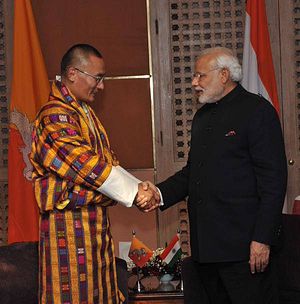At the 18th SAARC summit in Kathmandu, held in late November 2014, Indian Prime Minister Narendra Modi stated that regional integration in South Asia would go ahead “through SAARC or outside it, among all of us or some of us.” On June 15, 2015, the transport ministers of four South Asian neighbors – Bangladesh, Bhutan, India, Nepal, now better known as the BBIN – signed a landmark Motor Vehicles Agreement (MVA) in Thimpu. The agreement is expected to pave the way for a seamless movement of goods and people across their borders, encouraging regional integration and economic development.
Indian Transport Minister Nitin Gadkari commented, “This indeed is a momentous achievement for all the four neighbours. This historic agreement will further promote our cooperation in trade and commerce.” He added, “The Motor Vehicles Agreement is the ‘overarching’ framework to fulfill our commitment to enhance regional connectivity. The agreement will help in creating transport corridors linking the four countries into economic corridors as well as enable transit of passengers and goods along designated key routes in the four SAARC countries, thereby reducing the time-consuming exercise of disembarking of passengers.”
The agreement will be phased in over six months. The first phase will include the preparation of bilateral (and perhaps trilateral or quadrilateral) agreements and protocols for implementation of the MVA, to be completed by July 2015. The second phase will entail negotiation and approval of additional agreements and protocols, by September 2015. This will be followed by installation of the IT systems, infrastructure, tracking, regulatory systems and other tools for implementing the approved agreements, by December 2015, and then by gradual roll out from October 2015.
The joint statement claimed that transforming transport corridors into economic corridors could potentially boost intra-regional trade within South Asia by almost 60 percent, and with the rest of the world by more than 30 percent. The Asian Development Bank, with its support for the South Asian Subregional Economic Cooperation, has been helping to enhance interconnectivity between the four countries. The joint statement expressed pleasure with the progress of work to improve the physical road connectivity between the countries.
A BBIN Friendship Motor Rally is planned to be held in October 2015 to highlight the sub-regional connectivity and the scope and opportunities for greater people-to-people contact and trade under the BBIN initiative. In the meantime, there are some detailed negotiations that must be completed before the agreement is fully in place. Among other things, a series of issues related to cargo and passenger movement need to be settled, such as deciding on customs procedures, cargo and passenger volumes, transit fees, routes, and insurance. A joint customs sub-group will be formed to work out the required customs and other procedures with regard to vehicle entry and exit. Not all customs stations will be geared to entry of containers from neighboring countries; the traffic will be required to move through designated routes along the BBIN corridor. Failing to take the authorized routes will be treated as a violation of the permit conditions and relevant customs laws.
Despite the challenges that must be overcome before the BBIN MVA agreement is successfully implemented, it is nonetheless a positive development for the sub-regional grouping. It represents both progress and India’s willingness to lead. The MVA will help reduce transport costs and it will foster the development of transit facilities and multimodal transport that will in turn promote greater trade and improve connectivity between the BBIN countries.
Sub-regional cooperation in South Asia will lend impetus to India’s international trade and will also strengthen South Asia’s position as a regional trade hub. India stands to gain significantly in terms of trade, investment, assistance, and cooperation within the region, as well as in people-to-people contact and connectivity. The BBIN initiatives clearly reflect India’s ambitions for South Asian economic integration.
India should now seek also to coordinate with other sub-regional groupings beyond South Asia. Commenting on the initiative to strengthen connectivity with ASEAN, Gadkari said, “In this regard a major breakthrough has been achieved between India, Myanmar and Thailand. The three nations have agreed to develop a similar framework motor vehicle agreement on the lines of the draft SAARC Motor Vehicle Agreement. Secretary-level discussions were successfully concluded in Bengaluru this month and consensus has been reached on the text of the Agreement. On conclusion of this agreement, our sub-region will get access to the larger ASEAN market through seamless passenger and cargo movement.”
Sridhar Ramaswamy is a freelance writer with a Master’s degree in Indian Foreign Policy from the Jindal School of International Affairs, Sonepat.
































